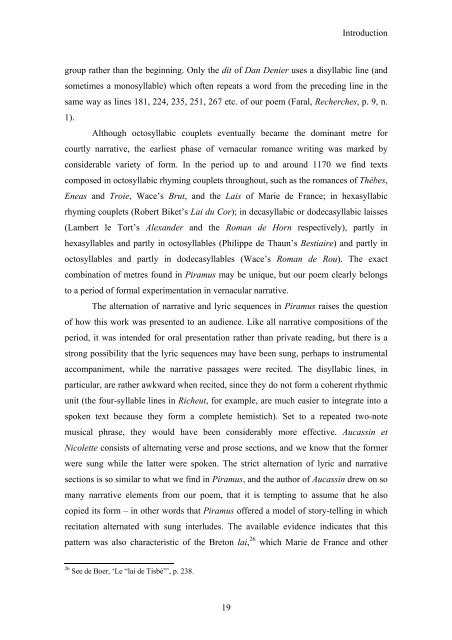You also want an ePaper? Increase the reach of your titles
YUMPU automatically turns print PDFs into web optimized ePapers that Google loves.
Introduction<br />
group rather than the beginning. Only the dit of Dan Denier uses a disyllabic line (and<br />
sometimes a monosyllable) which often repeats a word from the preceding line in the<br />
same way as lines 181, 224, 235, 251, 267 etc. of our poem (Faral, Recherches, p. 9, n.<br />
1).<br />
Although octosyllabic couplets eventually became the dominant metre for<br />
courtly narrative, the earliest phase of vernacular romance writing was marked by<br />
considerable variety of form. In the period up to and around 1170 we find texts<br />
composed in octosyllabic rhyming couplets throughout, such as the romances of Thèbes,<br />
Eneas and Troie, Wace’s Brut, and the Lais of Marie de France; in hexasyllabic<br />
rhyming couplets (Robert Biket’s Lai du Cor); in decasyllabic or dodecasyllabic laisses<br />
(Lambert le Tort’s Alexander and the Roman de Horn respectively), partly in<br />
hexasyllables and partly in octosyllables (Philippe de Thaun’s Bestiaire) and partly in<br />
octosyllables and partly in dodecasyllables (Wace’s Roman de Rou). The exact<br />
combination of metres found in Piramus may be unique, but our poem clearly belongs<br />
to a period of formal experimentation in vernacular narrative.<br />
The alternation of narrative and lyric sequences in Piramus raises the question<br />
of how this work was presented to an audience. Like all narrative compositions of the<br />
period, it was intended for oral presentation rather than private reading, but there is a<br />
strong possibility that the lyric sequences may have been sung, perhaps to instrumental<br />
accompaniment, while the narrative passages were recited. The disyllabic lines, in<br />
particular, are rather awkward when recited, since they do not form a coherent rhythmic<br />
unit (the four-syllable lines in Richeut, for example, are much easier to integrate into a<br />
spoken text because they form a complete hemistich). Set to a repeated two-note<br />
musical phrase, they would have been considerably more effective. Aucassin et<br />
Nicolette consists of alternating verse and prose sections, and we know that the former<br />
were sung while the latter were spoken. The strict alternation of lyric and narrative<br />
sections is so similar to what we find in Piramus, and the author of Aucassin drew on so<br />
many narrative elements from our poem, that it is tempting to assume that he also<br />
copied its form – in other words that Piramus offered a model of story-telling in which<br />
recitation alternated with sung interludes. The available evidence indicates that this<br />
pattern was also characteristic of the Breton lai, 26 which Marie de France and other<br />
26 See de Boer, ‘Le “lai de Tisbé”’, p. 238.<br />
19
















